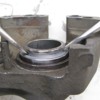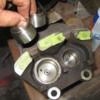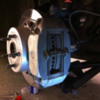The engine needs to come out to slosh the tank.
It takes a couple of hours to do the tank, yes, after the engine is out of the way!

Why presume the worst on the tank here? The tanks themselves are not that fragile.
What happens is that the fuel pickup on the early tanks with the steel welded in line rusts through around the level the gas was left at.
The way to deal with that is to install a new fuel pick up/sender assembly that has the pickup on the sender assembly.
BEFORE you go trying to open the drain plug in the bottom, pump everything out and examine the interior of the tank with a colon scope.

You can access a lot of the tank that would be gummed up with old fuel from the top access holes.
The only reason really to pull out the tank would be to solder up a hole and then to slosh the tank.
Sloshing it puts a very fine teflon coating on the inside.
If you have the early tank design, like I do, you are better off now getting the new version of the pickup.
The original fuel tube in the tank is about a 3/16" id and is restrictive. The fabric filter on the end usually wear through and is not servicable.
The new fuel line in the pickup is larger.
The reason I say, leave the drain alone is that it is sealed in place very tightly. The amount of torque you need to put on it to loosen it can tear the bung out of the tank.
GP, this should be a new thread?





